Brushing
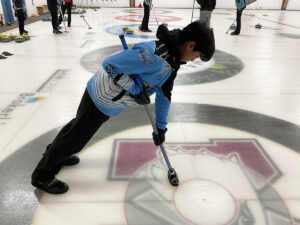
Does handedness matter in brushing?
Functional laterality – that is, handedness, footedness, and ocular dominance, are important physical characteristics in many team sports, such as ice hockey and baseball, or in racquet sports such as tennis, squash, and badminton. Handedness is often less of an issue in other sports, particularly individual sports, such as darts, or golf. Handedness, in particular, has been studied extensively [1,2]. Handedness refers to an individual’s preferential use of one hand over the other due to strength, quickness, or dexterity. The preferential hand is commonly referred to as the dominant hand. About 10% of the human population is left-handed, though this proportion does vary slightly by gender (males 10.5%, females 8.7%) [1,2], with 1% of the population being ambidextrous, having an equal ability with both hands. Taylor Stremick of Team Ashley Thevenot of Saskatoon being tested on a CurlSmart instrumented brush at the Sutherland Curling Club. To a significant degree, in many sports the advantage for a left-handed athlete is simply
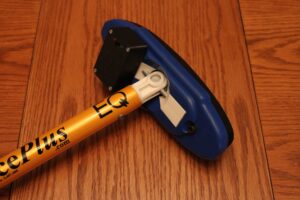
Instrumented Curling Brushes and the CurlSmart brush
I frequently receive questions about the instrumented brush that I use when testing athletes. An instrumented brush is a “game-changer” in the coaching of the sport of curling, because the effectiveness of an athlete cannot be determined statically (for example, by using a bathroom scale). Rather, brushing involves movement, and an instrumented brush is able to measure various characteristics of an athlete’s brushing profile to give essential guidance to a coach to help improve their technique. The instrumented brush that I use is a prototype developed by Dr. John Newhook of Dalhousie University, and is described in some detail in the article shown at right. In a nutshell, the brush captures (via a strain gauge) the vertical force generated through the handle at a sampling rate of 100 Hz. The force data from the brush is transmitted to a laptop Windows computer running proprietary software that (a) converts the values from the brush into “forces” in kilograms, for better understanding
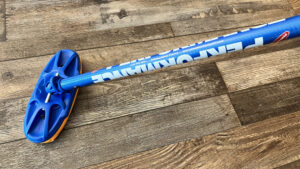
Curling brushes – Try before you buy – Part Deux
On April 13th I’ll be one of the coaches at the Ontario Curling Council U18 Academy camp at the Dundas Valley Golf and Curling Club in Dundas, ON. In the first part of this article I mentioned that one of things I like to do when coaching at a camp is to bring along a large broom bag with an assortment of brushes from my collection, so that the athletes have an opportunity to try out various brushes that are different from the one they use regularly. It is unsurprising to me how frequently an athlete will profess a liking for a particular brush in my collection that is different from the one they have. Most often that difference relates to the handle, and not the brush pad. While debate over the utility of the various brush pads from the different manufacturers continues, what is frequently overlooked are the handles, and the characteristics of a given handle does impact the
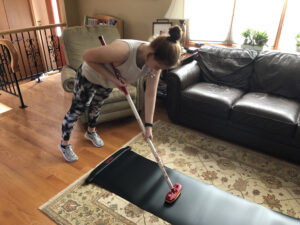
Can I use a bathroom scale to test brushing performance?
Recently I was asked if one could use an ordinary bathroom scale to test an athlete’s brushing performance. Obviously doing so would constitute a static test, so its usefulness is limited since brushing is an activity of movement; so much of brushing performance is dependent on one’s body position and footwork when one is moving with the stone down the sheet. Moreover, we also know that brushing performance (typically both stroke rate and vertical force) tails off with stones thrown at higher velocities. And, finally, we also know from mechanics that, formally, there is no generation of power without movement. In a static test with the brush on the scale, no movement is produced. Nonetheless, a static test using a bathroom scale can give an athlete an idea of the vertical force they can generate down the handle of the brush in a stationary position. It is extremely unlikely that this force will be duplicated on an ice surface, but
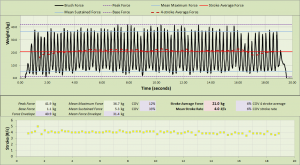
The Anatomy of a Brush Stroke
This article is joint work with Professor of Engineering John Newhook of Dalhousie University in Halifax. Click on the image above to view the PDF. In 2018 we documented the vertical forces and other characteristics of a brush stroke in order to better convey our understanding of the mechanics of brushing and how we might use this information to improve the coaching of the sport. This article, the first in our Technical Coach Series, is certainly not the first to document the variability in the forces achieved when brushing. To our knowledge, it would appear that researchers in the School of Engineering at the University of Edinburgh (B.A. Marmo, I.S. Farrow, M-P Buckingham, and J.R. Blackford) were the first to document the variability of forces during a brush stroke, and how these forces are generated on the ice, in various papers in 2005-2006 (see references below). Their results were later confirmed by other researchers in 2010-2012 in both Canada and
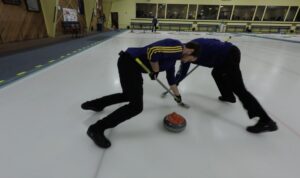
A short analysis of brushing studies
This article is joint work with Professor of Engineering John Newhook of Dalhousie University in Halifax. Click on the image above to view the PDF. Since we began our collaboration during the winter of 2013-2014, John Newhook and I have been compiling normative data on brushing, John in Nova Scotia and the Maritimes and myself largely in Ontario and occasionally in Saskatchewan. We felt that this work was important since the few studies of brushing performance of which we were aware had very small sample sizes and had predominantly illustrated the performance of male athletes. Since our initial trials in February 2014, John and I have together recorded over 2500 bouts for approximately 775 athletes across Canada. Many of these are Junior-aged athletes that we have worked with multiple times through annual high-performance camps, but we have also worked with younger athletes and with high-performance athletes who play on the Tour. As a result, from our study we have a